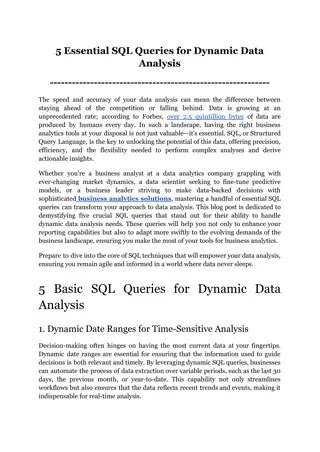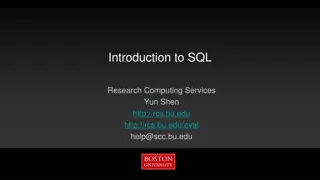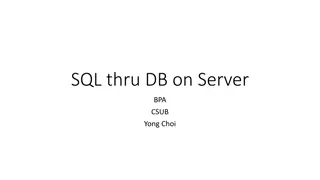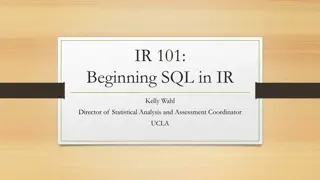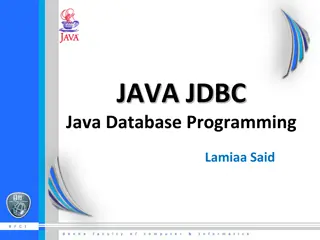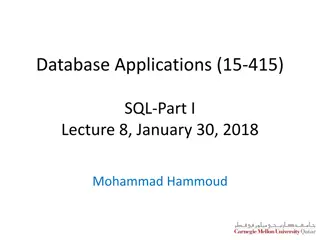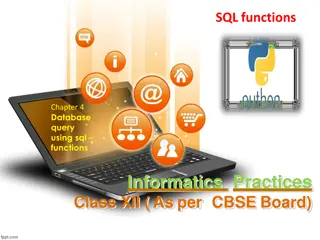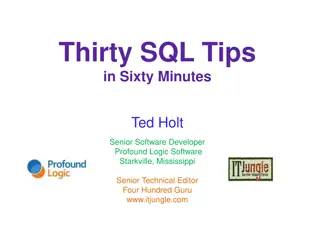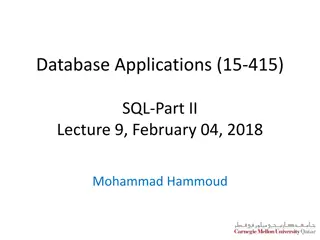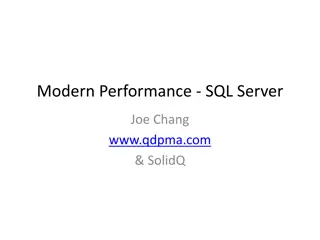
Introduction to SQL: Basics, Schema Definitions, and More
Explore the fundamentals of SQL in this lecture, covering topics such as basic schema definitions, keys, constraints, table creation, and the motivation behind using SQL. Discover the relational model of data and logical data independence, essential concepts in SQL development. Dive into the reasons for choosing SQL as the query language for managing relational databases and gain insights into its significance in the data realm.
Download Presentation

Please find below an Image/Link to download the presentation.
The content on the website is provided AS IS for your information and personal use only. It may not be sold, licensed, or shared on other websites without obtaining consent from the author. If you encounter any issues during the download, it is possible that the publisher has removed the file from their server.
You are allowed to download the files provided on this website for personal or commercial use, subject to the condition that they are used lawfully. All files are the property of their respective owners.
The content on the website is provided AS IS for your information and personal use only. It may not be sold, licensed, or shared on other websites without obtaining consent from the author.
E N D
Presentation Transcript
Lecture 2: Introduction to SQL
Lecture 2 Lecture 2 Announcements! 1. If you still have Jupyter trouble, let us know! 2. Enroll to Piazza!!! 3. People are looking for groups. Team up! 4. Enrollment should be finalized soon! 5. TA updates hopefully by Monday! 2
Lecture 2 Lecture 2 Lecture 2: Introduction to SQL
Lecture 2 Lecture 2 Today s Lecture 1. SQL introduction & schema definitions ACTIVITY: Table creation 2. Basic single-table queries ACTIVITY: Single-table queries! 3. Multi-table queries ACTIVITY: Multi-table queries! 4
Lecture 2 > Section 1 Lecture 2 > Section 1 1. SQL Introduction & Definitions 5
Lecture 2 > Section 1 Lecture 2 > Section 1 What you will learn about in this section 1. What is SQL? 2. Basic schema definitions 3. Keys & constraints intro 4. ACTIVITY: CREATE TABLE statements 6
Lecture 2 > Section 1 > SQL Lecture 2 > Section 1 > SQL SQL Motivation But why use SQL? The relational model of data is the most widely used model today Main Concept: the relation- essentially, a table Logical data independence: Logical data independence: protection from changes in the logical structure of the data Remember: The reason for using the relational model is data independence! SQL is a logical, declarative query language. We use SQL because we happen to use the relational model.
Lecture 2 > Section 1 > SQL Lecture 2 > Section 1 > SQL SQL Motivation Dark times 5 years ago. Are databases dead? Now, as before: everyone sells SQL Pig, Hive, Impala Not-Yet-SQL?
Lecture 2 > Section 1 > SQL Lecture 2 > Section 1 > SQL Basic SQL 9
Lecture 2 > Section 1 > SQL Lecture 2 > Section 1 > SQL SQL Introduction SQL is a standard language for querying and manipulating data SQL SQL stands for S Structured Q Query L Language SQL is a very high-level programming language This works because it is optimized well! Many standards out there: ANSI SQL, SQL92 (a.k.a. SQL2), SQL99 (a.k.a. SQL3), . Vendors support various subsets Probably the world s most successful parallel programming language (multicore?) parallel
Lecture 2 > Section 1 > SQL Lecture 2 > Section 1 > SQL SQL is a Data Definition Language (DDL) Define relational schemata Create/alter/delete tables and their attributes Data Manipulation Language (DML) Insert/delete/modify tuples in tables Query one or more tables discussed next! 11
Lecture 2 > Section 1 > Definitions Lecture 2 > Section 1 > Definitions Tables in SQL A relation relation or table multiset of tuples having the attributes specified by the schema table is a Product PName Price Manufacturer Gizmo $19.99 GizmoWorks Powergizmo $29.99 GizmoWorks Let s break this definition down SingleTouch $149.99 Canon MultiTouch $203.99 Hitachi 12
Lecture 2 > Section 1 > Definitions Lecture 2 > Section 1 > Definitions Tables in SQL A multiset multiset is an unordered list (or: a set with multiple duplicate instances allowed) Product PName Price Manufacturer Gizmo $19.99 GizmoWorks List: [1, 1, 2, 3] Set: {1, 2, 3} Multiset: {1, 1, 2, 3} Powergizmo $29.99 GizmoWorks SingleTouch $149.99 Canon MultiTouch $203.99 Hitachi i.e. no next(), etc. methods! 13
Lecture 2 > Section 1 > Definitions Lecture 2 > Section 1 > Definitions Tables in SQL Product An attribute attribute (or column is a typed data entry present in each tuple in the relation column) PName Price Manufacturer Gizmo $19.99 GizmoWorks Powergizmo $29.99 GizmoWorks SingleTouch $149.99 Canon MultiTouch $203.99 Hitachi Attributes must have an atomic type in standard SQL, i.e. not a list, set, etc. 14
Lecture 2 > Section 1 > Definitions Lecture 2 > Section 1 > Definitions Tables in SQL Product PName Price Manufacturer Gizmo $19.99 GizmoWorks Powergizmo $29.99 GizmoWorks SingleTouch $149.99 Canon A tuple tuple or row single entry in the table having the attributes specified by the schema row is a MultiTouch $203.99 Hitachi Also referred to sometimes as a record 15
Lecture 2 > Section 1 > Definitions Lecture 2 > Section 1 > Definitions Tables in SQL Product PName Price Manufacturer Gizmo $19.99 GizmoWorks The number of tuples is the cardinality cardinality of the relation Powergizmo $29.99 GizmoWorks SingleTouch $149.99 Canon MultiTouch $203.99 Hitachi The number of attributes is the arity the relation arity of 16
Lecture 2 > Section 1 > Definitions Lecture 2 > Section 1 > Definitions Data Types in SQL Atomic types: Characters: CHAR(20), VARCHAR(50) Numbers: INT, BIGINT, SMALLINT, FLOAT Others: MONEY, DATETIME, Every attribute must have an atomic type Hence tables are flat 17
Lecture 2 > Section 1 > Definitions Lecture 2 > Section 1 > Definitions Table Schemas The schema of a table is the table name, its attributes, and their types: Product(Pname: string, Price: float, Category: string, Manufacturer: string) A key is an attribute whose values are unique; we underline a key Product(Pname: string, Price: float, Category: string, Manufacturer: string) 18
Lecture 2 > Section 1 > Keys & constraints Lecture 2 > Section 1 > Keys & constraints Key constraints A key key is a minimal subset of attributes minimal subset of attributes that acts as a unique identifier for tuples in a relation A key is an implicit constraint on which tuples can be in the relation i.e. if two tuples agree on the values of the key, then they must be the same tuple! Students(sid:string, name:string, gpa: float) 1. Which would you select as a key? 2. Is a key always guaranteed to exist? 3. Can we have more than one key?
Lecture 2 > Section 1 > Keys & constraints Lecture 2 > Section 1 > Keys & constraints NULL and NOT NULL To say don t know the value we use NULL NULL has (sometimes painful) semantics, more details later Students(sid:string, name:string, gpa: float) sid name gpa 123 143 Bob Jim 3.9 NULL Say, Jim just enrolled in his first class. In SQL, we may constrain a column to be NOT NULL, e.g., name in this table
Lecture 2 > Section 1 > Keys & constraints Lecture 2 > Section 1 > Keys & constraints General Constraints We can actually specify arbitrary assertions E.g. There cannot be 25 people in the DB class In practice, we don t specify many such constraints. Why? Performance! Whenever we do something ugly (or avoid doing something convenient) it s for the sake of performance
Lecture 2 > Section 1 > Summary Lecture 2 > Section 1 > Summary Summary of Schema Information Schema and Constraints are how databases understand the semantics (meaning) of data They are also useful for optimization SQL supports general constraints: Keys and foreign keys are most important We ll give you a chance to write the others
Lecture 2 > Section 1 > ACTIVITY Lecture 2 > Section 1 > ACTIVITY ACTIVITY: Activity-2-1.ipynb 23
Lecture 2 > Section Lecture 2 > Section 2 2 2. Single-table queries 24
Lecture 2 > Section Lecture 2 > Section 2 2 What you will learn about in this section 1. The SFW query 2. Other useful operators: LIKE, DISTINCT, ORDER BY 3. ACTIVITY: Single-table queries 25
Lecture 2 > Section 2 > SFW Lecture 2 > Section 2 > SFW SQL Query Basic form (there are many many more bells and whistles) SELECT <attributes> FROM <one or more relations> WHERE <conditions> Call this a SFW SFW query. 26
Lecture 2 > Section 2 > SFW Lecture 2 > Section 2 > SFW Simple SQL Query: Selection PName Gizmo Powergizmo SingleTouch MultiTouch Price $19.99 $29.99 $149.99 $203.99 Category Gadgets Gadgets Photography Household Manufacturer GizmoWorks GizmoWorks Canon Hitachi Selection Selection is the operation of filtering a relation s tuples on some condition SELECT * FROM Product WHERE Category = Gadgets PName Gizmo Powergizmo Price $19.99 $29.99 Category Gadgets Gadgets Manufacturer GizmoWorks GizmoWorks 27
Lecture 2 > Section 2 > SFW Lecture 2 > Section 2 > SFW Simple SQL Query: Projection PName Gizmo Powergizmo SingleTouch MultiTouch Price $19.99 $29.99 $149.99 $203.99 Category Gadgets Gadgets Photography Household Manufacturer GizmoWorks GizmoWorks Canon Hitachi Projection Projection is the operation of producing an output table with tuples that have a subset of their prior attributes SELECT Pname, Price, Manufacturer FROM Product WHERE Category = Gadgets PName Gizmo Powergizmo Price $19.99 $29.99 Manufacturer GizmoWorks GizmoWorks 28
Lecture 2 > Section 2 > SFW Lecture 2 > Section 2 > SFW Notation Product(PName, Price, Category, Manfacturer) Input schema SELECT Pname, Price, Manufacturer FROM Product WHERE Category = Gadgets Answer(PName, Price, Manfacturer) Output schema 29
Lecture 2 > Section 2 > SFW Lecture 2 > Section 2 > SFW A Few Details SQL commands are case insensitive: Same: SELECT, Select, select Same: Product, product Values are not: Different: Seattle , seattle Use single quotes for constants: abc - yes abc - no 30
Lecture 2 > Section 2 > Other operators Lecture 2 > Section 2 > Other operators LIKE: Simple String Pattern Matching SELECT * FROM Products WHERE PName LIKE %gizmo% s LIKE p: pattern matching on strings p may contain two special symbols: % = any sequence of characters _ = any single character 31
Lecture 2 > Section 2 > Other operators Lecture 2 > Section 2 > Other operators DISTINCT: Eliminating Duplicates Category Gadgets Photography Household SELECT DISTINCT Category FROM Product Versus Category Gadgets Gadgets Photography Household SELECT Category FROM Product 32
Lecture 2 > Section 2 > Other operators Lecture 2 > Section 2 > Other operators ORDER BY: Sorting the Results SELECT PName, Price, Manufacturer FROM Product WHERE Category= gizmo AND Price > 50 ORDER BY Price, PName Ties are broken by the second attribute on the ORDER BY list, etc. Ordering is ascending, unless you specify the DESC keyword. 33
Lecture 2 > Section Lecture 2 > Section 2 2 > ACTIVITY > ACTIVITY ACTIVITY: Activity-2-2.ipynb 34
Lecture 2 > Section 3 Lecture 2 > Section 3 3. Multi-table queries 35
Lecture 2 > Section 3 Lecture 2 > Section 3 What you will learn about in this section 1. Foreign key constraints 2. Joins: basics 3. Joins: SQL semantics 4. ACTIVITY: Multi-table queries 36
Lecture 2 > Section 3 > Foreign Keys Lecture 2 > Section 3 > Foreign Keys Foreign Key constraints Suppose we have the following schema: Students(sid: string, name: string, gpa: float) Enrolled(student_id: string, cid: string, grade: string) And we want to impose the following constraint: Only bona fide students may enroll in courses i.e. a student must appear in the Students table to enroll in a class student_id alone is not a key- what is? Students Enrolled sid name gpa student_id cid grade 101 Bob 3.2 123 564 A 123 Mary 3.8 123 537 A+ We say that student_id is a foreign key foreign key that refers to Students
Lecture 2 > Section 3 > Foreign Keys Lecture 2 > Section 3 > Foreign Keys Declaring Foreign Keys Students(sid: string, name: string, gpa: float) Enrolled(student_id: string, cid: string, grade: string) CREATE TABLE Enrolled( student_id CHAR(20), cid grade CHAR(10), PRIMARY KEY (student_id, cid), FOREIGN KEY (student_id) REFERENCES Students(sid) ) CHAR(20),
Lecture 2 > Section 3 > Foreign Keys Lecture 2 > Section 3 > Foreign Keys Foreign Keys and update operations Students(sid: string, name: string, gpa: float) Enrolled(student_id: string, cid: string, grade: string) What if we insert a tuple into Enrolled, but no corresponding student? INSERT is rejected (foreign keys are constraints)! DBA chooses (syntax in the book) What if we delete a student? 1. Disallow the delete 2. Remove all of the courses for that student 3. SQL allows a third via NULL (not yet covered)
Lecture 2 > Section 3 > Foreign Keys Lecture 2 > Section 3 > Foreign Keys Keys and Foreign Keys Company What is a foreign key vs. a key here? CName GizmoWorks Canon Hitachi StockPrice 25 65 15 Country USA Japan Japan Product PName Gizmo Powergizmo SingleTouch MultiTouch Price $19.99 $29.99 $149.99 $203.99 Category Gadgets Gadgets Photography Household Manufacturer GizmoWorks GizmoWorks Canon Hitachi 40
Lecture 2 > Section 3 > Joins: Basics Lecture 2 > Section 3 > Joins: Basics Joins Product(PName, Price, Category, Manufacturer) Company(CName, StockPrice, Country) Note: we will often omit attribute types in schema definitions for brevity, but assume attributes are always atomic types Ex: Find all products under $200 manufactured in Japan; return their names and prices. SELECT PName, Price FROM Product, Company WHERE Manufacturer = CName AND Country= Japan AND Price <= 200 41
Lecture 2 > Section 3 > Joins: Basics Lecture 2 > Section 3 > Joins: Basics Joins Product(PName, Price, Category, Manufacturer) Company(CName, StockPrice, Country) Ex: Find all products under $200 manufactured in Japan; return their names and prices. SELECT PName, Price FROM Product, Company WHERE Manufacturer = CName AND Country= Japan AND Price <= 200 A join join between tables returns all unique combinations of their tuples which meet some which meet some specified join condition specified join condition 42
Lecture 2 > Section 3 > Joins: Basics Lecture 2 > Section 3 > Joins: Basics Joins Product(PName, Price, Category, Manufacturer) Company(CName, StockPrice, Country) Several equivalent ways to write a basic join in SQL: SELECT PName, Price FROM Product JOIN Company ON Manufacturer = Cname AND Country= Japan WHERE Price <= 200 SELECT PName, Price FROM Product, Company WHERE Manufacturer = CName AND Country= Japan AND Price <= 200 A few more later on 43
Lecture 2 > Section 3 > Joins: Basics Lecture 2 > Section 3 > Joins: Basics Joins Product Company Country USA Japan Japan PName Gizmo Price $19 Category Gadgets Manuf GWorks Cname GWorks Canon Hitachi Stock 25 65 15 Powergizmo $29 Gadgets GWorks SingleTouch $149 Photography Canon MultiTouch $203 Household Hitachi SELECT PName, Price FROM Product, Company WHERE Manufacturer = CName AND Country= Japan AND Price <= 200 PName SingleTouch Price $149.99 44
Lecture 2 > Section 3 > Joins: Semantics Lecture 2 > Section 3 > Joins: Semantics Tuple Variable Ambiguity in Multi-Table Person(name, address, worksfor) Company(name, address) Which address does this refer to? ? SELECT DISTINCT name, address FROM WHERE worksfor = name Person, Company Which Which name s name s?? ?? 45
Lecture 2 > Section 3 > Joins: Semantics Lecture 2 > Section 3 > Joins: Semantics Tuple Variable Ambiguity in Multi-Table Person(name, address, worksfor) Company(name, address) SELECT DISTINCT Person.name, Person.address FROM Person, Company WHERE Person.worksfor = Company.name Both equivalent ways to resolve variable ambiguity SELECT DISTINCT p.name, p.address FROM Person p, Company c WHERE p.worksfor = c.name 46
Lecture 2 > Section 3 > Joins: semantics Lecture 2 > Section 3 > Joins: semantics Meaning (Semantics) of SQL Queries SELECT x1.a1, x1.a2, , xn.ak FROM R1 AS x1, R2 AS x2, , Rn AS xn WHERE Conditions(x1, , xn) Almost never the fastest way to compute it! Answer = {} for x1in R1do for x2in R2do .. for xnin Rndo if Conditions(x1, , xn) then Answer = Answer {(x1.a1, x1.a2, , xn.ak)} return Answer Note: Note: this is a multiset union 47
Lecture 2 > Section 3 > Joins: semantics Lecture 2 > Section 3 > Joins: semantics An example of SQL semantics Output SELECT R.A FROM R, S WHERE R.A = S.B A 3 3 A 1 3 A B C 1 2 3 1 3 4 1 3 5 3 2 3 3 3 4 3 3 5 Cross Product Apply Projection Apply Selections / Conditions B C 2 3 3 4 3 5 A B C 3 3 4 3 3 5 48
Lecture 2 > Section 3 > Joins: semantics Lecture 2 > Section 3 > Joins: semantics Note the semantics semantics of a join SELECT R.A FROM R, S WHERE R.A = S.B Recall: Cross product (A X B) is the set of all unique tuples in A,B 1. Take cross product: ? = ? ? Ex: {a,b,c} X {1,2} = {(a,1), (a,2), (b,1), (b,2), (c,1), (c,2)} 2. Apply selections / conditions: ? = ?,? ? ?.? == ?.?} = Filtering! 3. Apply projections to get final output: ? = (?.?,) ??? ? ? = Returning only some attributes Remembering this order is critical to understanding the output of certain queries (see later on ) 49
Lecture 2 > Section 3 > Joins: semantics Lecture 2 > Section 3 > Joins: semantics Note: we say semantics not execution order The preceding slides show what a join means Not actually how the DBMS executes it under the covers


